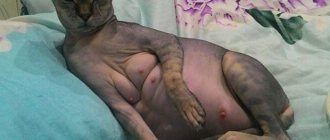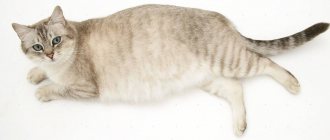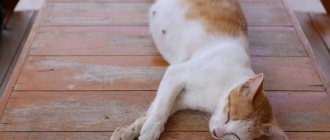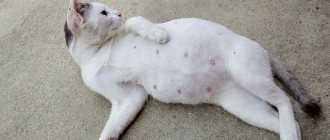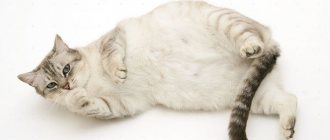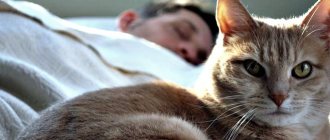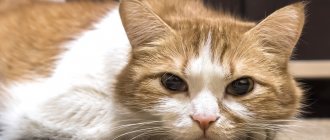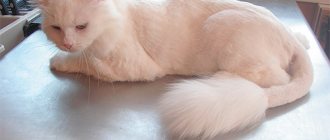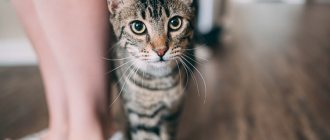A cat's first pregnancy is always an exciting time for its owner and a period of changes in the body and habits for the animal getting used to a new role. The birth of a new life and the gestation of a fetus are events that change your pet, forcing her to treat herself more carefully and seek rest. You can understand whether fertilization has occurred already from the third week after mating. Alas, tests for pets have not yet been invented, so the only option for the owner is to go to the veterinarian - a specialist will examine the cat, palpate and do an ultrasound, during which you will be able to see with your own eyes a tiny kitten - for now a small embryo on the screen of the device.
photo from website: cats.about.com
How to determine if a cat is pregnant at home: first signs in the early stages
Still, it also happens that you can’t get to the doctor, but you really want to find out about the likelihood of an “interesting situation.” Take a closer look at the cat’s behavior - it can “give itself away”:
- The first sign you may notice is the cessation of estrus. If the pet that was asking to go outside resolutely refuses to go out, stops making uterine sounds and loses all interest in males, expect a new addition to the cat family. However, it may not exist - everything is individual.
- Another sign that is hard to miss is drowsiness. Priorities are changing - now the first place is taken by proper rest. Your pet no longer runs after a ball or toy mouse. She has more important things to do - she saves the strength to bear the fetus.
photo from the site: www.catster.com
- The nipples of a pregnant cat change their color - from pale and almost invisible they become pink. This can be detected by turning the animal over on its back.
- Also, a young mother can eat selectively and very little. You should not be afraid of a decrease in appetite when trying to force feed your pet - this is a natural process associated with the birth of a new life in it. Often, cats, just like many women experiencing pregnancy, feel sick. Here, as in the case of people, everything is individual - some females develop toxicosis, while others do not.
Do not forget
However, if you want to know for sure, wait - in the first two weeks, changes in the animal’s behavior may be completely unnoticeable. The doctor knows how to determine pregnancy in a cat in the early stages - 21 days after a successful mating: he can be called to your home by prior arrangement if you do not want to disturb your four-legged pet.
If the fruits are dead...
Sometimes a phenomenon called fetal resorption in a cat can occur, in which resorption (resorption) of the fetus occurs in the uterus. This undesirable effect occurs under various unfavorable conditions: the cat’s health condition and external factors. If the fetus dies in the early stages, while the skeletal system is not formed, this most often passes without negative consequences for the cat’s health. If resorption occurs in the later stages, then such phenomena as mummification (drying), maceration (softening of tissues), petrification (deposition of lime) and putrefaction (putrefactive decomposition) are observed. Such conditions can be life-threatening for the cat and require veterinary intervention.
How to find out if a cat is pregnant: late symptoms
If you did not immediately notice the changes indicating conception, take a closer look at the animal a few weeks after meeting the cat: such signs can be much brighter than those that appeared in the early stages and were an exclusively individual phenomenon.
photo from website: www.wowamazing.com
- Overeating - your cat's appetite can become inflamed in earnest - she begins to eat for two and literally does not leave the bowl. You should not overfeed the animal - obesity will complicate childbirth and can negatively affect the development of the fetus. If in the first weeks the number of meals per day is 2-3, then from the third or fourth week this figure changes - the pet should eat up to 4-5 times per day .
- An enlarged abdomen is the most expected symptom that indicates fetal growth. It is observed already in the fourth or fifth week, and a sharp increase in the 6th may indicate that there is more than one embryo in the mother’s womb. It is necessary to palpate the abdominal cavity very gently and carefully - babies are vulnerable, and strong pressure can provoke a miscarriage. It is better to entrust this to a doctor.
- Changing nipple size is another sign that your cat is in an interesting position and is getting ready to feed her kittens.
- Changes in behavior - the hormonal background of a pet changes, and it is not surprising if an affectionate animal suddenly begins to show aggression and irritability or, conversely, demand increased attention to itself.
- Finding a safe place - the nest for babies should be warm and as comfortable as possible for newborns. That is why the cat looks for it so anxiously - it looks closely at all the secret corners and bedding. Help your pet arrange a temporary habitat so that nothing threatens the kids - neither drafts, nor annoying and frightening noise.
Nutritional Features
Nutritional needs change throughout pregnancy. The first two weeks, when appetite increases slightly, the daily portion is increased by 10%. In this case, the entire volume of food is divided not into 2 meals, as usual, but into 4–5. From 3 to 7 weeks, the amount of feed is doubled from the original. Over the last fortnight, my appetite has decreased slightly as the fruits put pressure on my internal organs.
Pregnant cats have a good appetite
The diet should not contain foods from the human table, especially those containing chemical additives - chips, sausages, smoked meats, including fish. This is harmful to all domestic animals, and their benefits for humans are questionable.
Nomes for feeding cats
Dry or natural food?
Cat breeders have not yet come to a consensus on which food is better - industrial or natural. But they agree on one thing: if it is ready-made food, then it must be the highest quality available. Switching to a different type of diet will do more harm than good.
Cat breeders never tire of arguing about which food is best.
Dry food familiar to cats is gradually being replaced with analogues for pregnant women. If a special product cannot be found, then simply increase the portion as described above. Experienced breeders recommend special foods for pregnant cats:
Royal Canin Queen
Acana Pacifica
Bozita
Josera Minette for kittens and nursing cats
These brands fall into the holistic and premium categories. They contain a sufficient amount of fat, protein, and amino acids to provide the expectant mother with energy for pregnancy and strengthen her immune system.
Kitten food is one of the options for complete nutrition for a pregnant or lactating cat.
In addition to the main diet, from time to time you can pamper your cat with natural products - meat, cottage cheese, yogurt. But then this is a delicacy, not the main food.
Many sources on cat nutrition note that it is not worth giving additional vitamins and minerals, since everything necessary is included in the product. Only a veterinarian can determine the possible need for supplements.
Natural nutrition
Breeders pay special attention to the natural nutrition of the cat. table 2
Qualitative composition of a pregnant cat's diet
Table 2. Qualitative composition of the diet of a pregnant cat.
| Name | Quantity, % |
| Squirrels | 25 |
| Carbohydrates | 25 |
| Fats | 12 |
| Cellulose | 2-3 |
| Minerals | 6 |
| Water | 29-30 |
Cats usually refuse plant foods. But if you grind it in a blender to a puree and mix it with meat products, then its taste buds can be deceived. You should not cut food into cubes, since only meat pieces will be selected from the plate.
A cat needs the following products:
- dietary meat - chicken, veal, beef (can be raw, but only fresh and high quality);
- sometimes - boiled fish;
- eggs - 2 pcs. in Week;
- low-fat dairy group - cottage cheese, yogurt, sour cream, cream, yogurt;
- cereals - oatmeal, rice, buckwheat;
- jelly, boiled cartilage.
Natural products are necessary for a pregnant cat
For constipation, give the cat beets and increase the amount of vegetable fat. But they are excluded or the dose is reduced after the condition has stabilized.
Herbal remedies for pregnant cats
Breeders recommend giving cats an infusion of raspberry leaves. It is prepared from a tablespoon of dry raw materials and a glass of boiling water, left for 15 minutes and filtered. Give a tablespoon 2 times a day from the beginning to the end of pregnancy. This will help bear healthy offspring and simplify the birth process.
In the second half of pregnancy, pre-scalded nettle leaves are added to the drink. These greens promote milk production.
Nettle decoction increases the amount of breast milk
Vitamin supplements for a pregnant cat
It is necessary to ensure the presence in the diet of vitamins A, D, E, B1, B6, B1, as well as calcium, phosphorus, iron, iodine. Taurine, a sulfur-containing amino acid, is extremely important. If the diet is prepared correctly and is not monotonous, the body receives most of these elements from food. But with an unbalanced diet, vitamin preparations with the listed substances are necessary.
The following brands offer vitamin complexes for pregnant cats:
- Beaphar (Top 10 Cat, Salvical, Irish Cal);
- Brewers Yeast 8 in 1;
- Anivital FeliImmun and others.
Vitamin preparations will provide vital elements
How pregnancy manifests itself in different breeds: Scottish Fold cat
photo from website: www.pets4homes.co.uk
Already in the first days after conception, the favorite Scottish Fold breed begins to signal its owner about its position - it becomes drowsy and eats more and more. To support the body during this difficult period for the animal, you can give your pet vitamins with a high calcium content. Some females develop toxicosis between 3 and 4 weeks, and on days 21-28 of pregnancy, the nipples of the future nurse swell and change color.
It is still not recommended to feel the enlarged belly on your own - it is better to entrust this to a veterinarian, who will not only palpate, but also do an ultrasound to make sure that the fetus is developing correctly. If there are children in the house, explain to them that a pregnant cat cannot be picked up - it can be harmed with one awkward touch.
By the middle of the term, it is necessary to increase the number of meals per day - from 2-3 to 4-5. The diet must include:
- boiled lean fish;
- hard-boiled eggs;
- porridge from rice, buckwheat, oatmeal;
- low-fat cottage cheese;
- vegetables and fruits as a necessary natural source of vitamins.
The last point will be especially relevant if the cat has constipation - in this case, you can give her beet puree. To improve lactation, Scottish Folds are given a salad of nettle leaves - they are finely chopped and doused with boiling water.
How does mating happen?
Cats mature at 6–7 months. It is during this period or a little later that they have their first heat. However, the body needs a few more months to fully develop. Mating is carried out only for the third time of sexual heat. The optimal age is about one and a half years.
Attention! The first heat is not suitable for pregnancy even with late puberty. But there is no need to delay either: this is fraught with diseases of the reproductive organs .
The cat is looked for in advance, especially during breeding. The female and male are preliminarily checked for the presence of infections, viruses, and anomalies. Two weeks before mating, preventive deworming is carried out.
The cat is not washed immediately before mating. Water and cosmetics destroy the natural odor that attracts the male. The meeting is scheduled for 3–5 days from the start of estrus. This is the most productive period when the probability of fertilization is highest. To do this, they usually choose “male” territory.
The fact that a cat is ready for sexual intercourse upon meeting is indicated by flirting with a sexual partner. Owners should be on alert, because animals can be injured during mating games.
The duration of one sexual act is 30 seconds. At the same time, the cat purrs, and the partner responds with a loud cry. During coitus, an egg is released from the ovaries, and fertilization occurs within 24 hours. Mating can be repeated 5–8 times. When the process is over, the cat begins to roll on its back, and the cat moves away and licks itself to the side.
Mating in cats
Important! One coating is not always enough to conceive. Therefore, sometimes, in order to achieve results, you don’t have to pick up the cat right away, but leave it with the cat for 1–2 days.
Sometimes the cat is left with a partner
Video - Cat flirts with cat
How is pregnancy progressing in a British cat?
photo from the site: www.suggest-keywords.com
Do not expect that the estrus of a British cat will stop after a successful mating - it will continue exactly as long as it is measured by nature and physiology. For the first few weeks, nothing indicates the “interesting situation” of the pet. The first sign you should pay attention to is changing color and enlarged nipples. Such a change manifests itself first in cats that have already given birth and a little later in animals for which pregnancy was the first.
As a rule, gestation of kittens lasts from 63 to 70 days for British women. Appetite increases in the second half of the term. Then the belly increases. The pet is resting more and more and behaves much calmer.
Pregnancy of an Abyssinian cat: what you need to know
photo from website: www.golfian.com
Most often, the Abyssinian bears kittens from 63 to 65 days, but each case is individual. Conception occurs one day after successful mating. Days 20 and 30 are the period when the first signs begin to appear - the nipples change color and swell, the cat becomes calm, sleeps more, eats for two with a greater appetite. Often during the first weeks, the expectant mother is overcome by nausea. The tummy rounds and increases in size at 5-6 weeks - this indicates that the fetus is developing, descending into the abdominal cavity. At this time, babies in the womb are especially vulnerable, and palpation is unacceptable.
Such changes in the body cause the following symptoms:
- loss of appetite;
- discharge from the vulva;
- enlargement of the nipples (when pressed, colostrum comes out).
Shortly before the onset of labor, your pet will begin to look for a nest for herself and her kittens, go to the toilet frequently, and uterine contractions will be visually noticeable.
Bengal cat pregnancy
photo from website: www.youtube.com
As a rule, it lasts 64 days. Significant changes in behavior appear within a few weeks - the pet begins to more actively seek the attention and affection of its owners and jealously guards its territory. The middle of the first trimester can bring with it toxicosis, and in the second trimester the tummy begins to grow. In recent weeks, it is better to stick to fractional feeding, without getting carried away with drying and, if possible, replacing it with natural products - fish, cereals, vegetable purees.
Interesting fact
Pregnancy is not a reason for Bengal cats to stop playing. They will still run around the house for toys and discover new and new entertainment. That is why it is important to ensure that the animal does not inadvertently harm itself and the babies. Protect the expectant mother from possible risks - excessive activity can affect the health of the mother and kittens.
Postpartum cat care
Immediately after birth, feel your cat's tummy to make sure all kittens have been born. After the birthing procedure, the animal is weakened and therefore immediately falls asleep. He sleeps for a long time until the exhausted body fully comes to its senses. When your cat wakes up, examine her even more carefully, looking for drooling, seizures, fever, or movement disturbances. If any of the above are noticed, contact your veterinarian immediately. Very often after childbirth, the body does not absorb calcium. This painful condition is called eclampsia.
How to care for a cat after giving birth
During this period, the animal will constantly be with the offspring, without leaving a single step, so make sure that everything you need is nearby: a litter tray, a plate of food and, of course, water. The cat will drink a lot, especially in the first hours after giving birth. Provide the “young family” with peace. Keep children away, who will naturally want to see small cats. Explain that you can’t approach them yet, you need them to grow up a little.
Immediately after giving birth, remove traces of mucus and blood discharge from her house, lay down a new cloth or diaper. The fabric should be natural, for example, flannel. Level it so that the cats, when climbing on it, do not get confused or cling.
Postpartum cat nutrition
This is the main and most important part of postpartum care. During this period, the animal should receive nutritious, but light food. It is necessary to feed more often than usual, about 5-6 times, but give it little by little so that the cat does not overeat. It is necessary to add dairy products to the animal’s regular diet and increase the amount of phosphates and calcium contained in bone meal.
Sterilization of a cat after birth
Many people wonder whether it is possible to sterilize a cat after giving birth, the answer is yes it is possible, but the pet must be allowed to recover after giving birth for several months. Otherwise, you can harm your cat's health. A veterinarian will give you a more professional answer on the issue of sterilization.
Maine Coon cat pregnancy
photo from website: purrfectcatbreeds.com
Characteristic signs of an “interesting situation” are drowsiness, toxicosis (individually), swollen nipples and a gradually enlarging belly. It is recommended to give your pet vitamins with a high calcium content. Allow the expectant mother to find a place to rest that she likes, do not forget to ventilate the room and treat the cat with the utmost gentleness. Prepare everything for future births and do not forget that the diet for your pet should be varied. It is possible to add vitamin and mineral supplements as recommended by your doctor.
Photos of pregnant cats
A cat is in heat - how does it happen and how can you help your cat? First signs and symptoms (115 photos)- Animal Raccoon - species, habits, interesting facts about life in the wild
Cat repellers - what they are and how they work. Prices, models and manufacturers of safe and effective devices (135 photos)
Read here How valerian works for cats - a description of the action, features of use and advice from veterinarians on choosing the dosage of tinctures and tablets
Help the site, share with friends 
Pregnancy in Sphynx cats
photo from the site: stylecat.ru
The first signs indicating future replenishment are:
- enlargement of the nipples and noticeable thinning of the hair around them (by day 40);
- weight gain (up to 1.5 kg);
- belly growth.
Pregnancy in Sphynx cats lasts from 58 to 72 days. In recent weeks, the animal becomes clumsy, especially if the birth of not one, but several kittens is planned.
What's the norm?
Knowing in advance how many kittens will appear, especially if the birth is the first, is not only a matter of convenience, but also safety for the animal. The owner will be able to prepare to provide assistance if a large offspring is expected. In addition, you can find new homes for the kids in advance, and breeders could calculate the benefits from selling club kittens.
The exact number of kittens is difficult to predict. Conclusions can be drawn based on statistics. Usually 4 to 6 kittens are born. But there have been cases of the birth of more than 10 healthy babies.
Fact! In 1970, the cat Antigone gave birth to 19 kittens. And a mother from South Africa named Bluebell has 14, and they all survived.
Breeders sometimes rely on this method of determining the number of offspring: you need to look at how many nipples the cat has. Subtract 2 from the sum. The resulting figure will be an approximate number. This method is certainly not accurate, but can be adopted.
At the physiological level, the offspring depends on how many fertilized eggs attach to the wall of the uterus. Veterinarians advise checking the offspring with an ultrasound machine a week before birth.
Important! You should not feel the belly of a pregnant cat with your hands. On the one hand, this can lead to stress for the expectant mother, and on the other hand, it can harm the babies.
Young and old cats give birth to fewer kittens, while middle-aged cats give birth to the maximum number. In addition, pets living in comfort have fewer children than domestic ones. Scientists explain this fact by the need to continue the birth in unfavorable conditions in which not all newborns will be able to survive.
If a record number of babies are born, this often leads to high mortality, especially if this happens in street animals. They appear with a very small body weight, and the mother's milk is often not enough to feed everyone.

